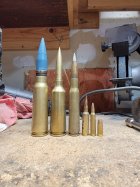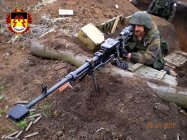Well with this im thinking I'm gonna keep it more geared towards focusing on long range and elr stuff and how a few guys who know what their doing can really screw with a much larger more technology advanced opponent.
Idk I'm stuck between having it being a military unit something akin to Canadian JDF guys ( well known for being long range / elr guys ) , civilian long range /elr guys , or idk mabye a bunch of good ole boys with some updated Barrett MacMillan Tac 50's or similar. Kinetic vs energy weapons and shields old school basic human guerilla warfare mixed with new aged tech . Idk still kicking this around
Wolfdog -
Howdy !
Thinking out loud....
What would make the man-sized " target " 3mi out be a threat ?
" ... IF the enemy is within range... so are you ". That being the case, your weapon intended for use against the threat; should out-range the threat weapon.
I don't think this hypothetical engagement would be some sort of " mano a mano " scenario.
There's a lot of things that would need to take place....
Target " cueing ":
The good guy shooter would likely be given a " cue " for the presence of a threat/possible threat in the more local area. This would come from friendly force satellite imagery, overhead drone; or orbiting Intelligence/Surveillance/Reconnaissance aircraft.
They'd become informed.
Target detection/discrimination/ID:
The shooting team would then use their own electro/optical device that they'd have with them, to detect and ID the target; after picking it out from amongst things like cover, concealment, decoys, other personnel; et al. And... maintain a positive ID thereafter.
Target tracking:
It could be a moving or at least rapidly re-locatable target. This has implications for how quickly the target can be engaged, and also for how it might negatively impact likelyhood of a successful engagement.
Targeting:
Electro/optical devices w/ the team would have greatly reduced capabilities; compared to the systems that provided initial target cueing.
Target Engagement:
The chosen weapon would be employed to engage the enemy ( here... at 3mi distance ).
Post-attack assessment:
Was the threat presented by the target removed/eliminated ?
Re-attack target as necessary:
Self explanatory
I mention all that because they have significant influence over weapon and sensor/sight design and capabilities. Can all you want done be done w/ the weapon and sighting system at hand ? If it ends up a crew served weapon, that suggests the weapon " system" arrives in multiple segments, and would have some size & weight constraints placed upon it.
Other.....
Sabotted rounds:
During the " Battle of 73 Easting ", an M1 Abrams engaged an Iraqi tank @ 2mi, using a sabotted round; and destroyed the ( Russian-made ) tank. That was a tank-size target.
Sabots allow use of sub-calibre munitions within a larger bore. I doubt a sabot system would be employed if the gun could be made to perform well, using a case that has itself been necked-down to the final calibre desired.
" Flechettes ":
I don't think these would be viable for use @ the stated distance.
During the Iraq war, a civilian was talking to a Western journalist about a wound he had sustained; when the U.S.S. Wisconsin had fired up on his coastal village. The civilian pointed out a concrete wall that had been penetrated by flechettes, one thereafter passing completely through his upper thigh. Fluid was still visibly weeping from the wound.
From what I have been able to find, the flechettes were carried within a " cargo round " fired from a 16-inch/50 calibre Mk 7 Naval cannon @ a Mv of 3,600fps. Remaining velocity upon flechette deployment from the " cargo round " was around 2,500fps. The civilian was still walking & talking, after being engaged by a specialized 16" shell; fired from a few miles away.
How high a priority target elimination is:
That has a major influence on kill chain decision making. Is it time critical ? Chance for collateral damage ? If the target can be detected and ID' d from the air, then it could also likely be engaged from the air. The Air Force doesn't typically drop bombs lighter than a 25lb practice bomb. The newer GBU-39B " Small Diameter Bomb " weighs 250lb, including its guidance package. The latter is intended for precision attack w/ minimized collateral damage. Image a bomb dropped on the target, that covered it with a lot of fast-setting resin.... effectively glueing the target in-place. Work has been done in this area.
But, if it has to be a gun; then so be it.
As far as advances in technology goes....
There are varying possible options:
- Use a dumb gun w/ that fires a smart projectile
- Use a highly-accurate gun that fires a dumb projectile
- Use an accurate gun that fires a smart projectile.
- Other
Let's remember.... a smart projectile would likely also need to have a built-in means to perform mid-trajectory and cross-range course corrections. Taken together, that implies a certain amount of projectile size & weight will be required. Right now, that would almost certainly imply a small calibre cannon round ( IMHO ). There are already small calibre cannons that fire " smart " projectiles ". IMHO - there will be opportunities for increased miniaturization in weapons fuzing and guidance packaging in the on-going years.
Directed energy weapons:
Use of a laser would be problematic, due to things like potential " atmospheric blooming " of the beam; and a probable requirement for the beam to have a certain amount of dwell time on-target to be effective. Moreover... can a viable beam be successfully propagated through things like dense foliage ?
With regards,
357Mag





 ) would think.
) would think.
















